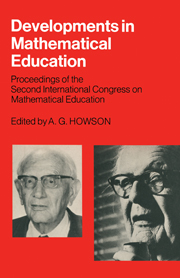 Developments in Mathematical Education
Developments in Mathematical Education Book contents
- Frontmatter
- Contents
- Editor's Acknowledgements
- PART I A CONGRESS SURVEY
- PART II THE INVITED PAPERS
- PART III A SELECTION OF CONGRESS PAPERS
- Investigation and problem-solving in mathematical education
- Intuition, structure and heuristic methods in the teaching of mathematics
- Mathematics and science in the secondary school
- Geometry as a gateway to mathematics
- The International Baccalaureate
- The role of axioms in contemporary mathematics and in mathematical education
- Implications of the work of Piaget in the training of students to teach primary mathematics
- Are we off the track in teaching mathematical concepts?
- Appendices
- Index
The International Baccalaureate
from PART III - A SELECTION OF CONGRESS PAPERS
- Frontmatter
- Contents
- Editor's Acknowledgements
- PART I A CONGRESS SURVEY
- PART II THE INVITED PAPERS
- PART III A SELECTION OF CONGRESS PAPERS
- Investigation and problem-solving in mathematical education
- Intuition, structure and heuristic methods in the teaching of mathematics
- Mathematics and science in the secondary school
- Geometry as a gateway to mathematics
- The International Baccalaureate
- The role of axioms in contemporary mathematics and in mathematical education
- Implications of the work of Piaget in the training of students to teach primary mathematics
- Are we off the track in teaching mathematical concepts?
- Appendices
- Index
Summary
PART I – GENERAL
International schools
The need for international schools was first publicly recognised in 1924 with the foundation of the International School of Geneva, largely to cater for the families of officials working in the headquarters of the League of Nations. Since then the steady growth of the great international companies and the world-wide operations of the United Nations has caused this pattern to be followed in many cities all over the world. Dozens of international schools have sprung up to cater for the children of a largely mobile population of families from overseas. Children who attend these schools come from a multitude of backgrounds, stay in one area for varying periods of time and have an enormous number of different plans for further education in colleges, universities and training schemes.
International schools can now be broadly divided into two types of foundation:
(i) schools whose main purpose is to serve the foreign families living in the area (for example, the International School of Geneva and the International College of Beirut);
(ii) schools whose main purpose is to serve the cause of international understanding, cooperation and peace (for example, Atlantic College in Wales, UK, the first of a developing chain of United World Colleges).
- Type
- Chapter
- Information
- Developments in Mathematical EducationProceedings of the Second International Congress on Mathematical Education, pp. 254 - 261Publisher: Cambridge University PressPrint publication year: 1973
